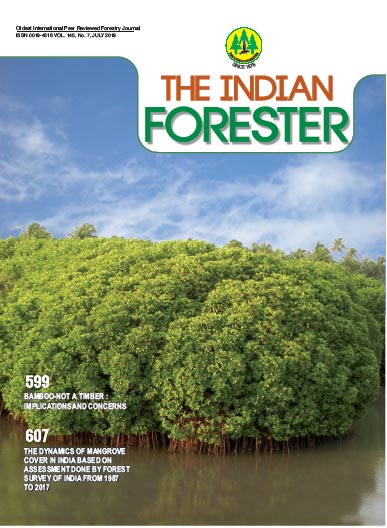Above Ground Biomass and Carbon Stock Mapping using NDVI and Ecological Studies of Woody Trees of Jeypore Reserve Forest, Assam, India
DOI:
https://doi.org/10.36808/if/2019/v145i7/147013Keywords:
Tropical Forest, Above Ground Biomass, Carbon Stock, NDVI, IVI.Abstract
Jeypore Reserve Forest of eastern Assam is one among the few remaining tropical forest patches, lying in the fringe of Assam-Arunachal Pradesh state border. Role of tropical forests in global biogeochemical cycles, especially the carbon cycle and its relation to the greenhouse effect, has heightened interest in estimating the biomass density of tropical forests. A field survey on this forest using 60 sample points of 100m × 100m dimension showed that remote sensing can provide information critically required for AGB and carbon stock assessment of the woody trees. The study was carried out with the aim to prepare AGB and carbon stock map of the forest using NDVI and to study the species richness, species diversity and IVI of the forest. Upon plotting NDVI values generated from Resourcesat-2 IRS P6 LISS III image and against AGB values it showed a rising trend, exponential curve was found to be the best fit. The regression equation derived was validated using 10 sample points and it was found that AGB values obtained from the field and obtained using the regression equation showed 98% correlation. Results of ecological studies revealed that Jeypore Reserve Forest have high species diversity of woody trees in scale of Shannon-Weaver index and IVI ranks Dipterocarpus retusus Blume as the most dominant species.References
Barbour M., Burk J.H., Pitts W.D., Gillians F.S. and Schwartz M.W. (1999). Terrestrial Ecology. Addson Wesley Longman Inc, Illinois, Chicago.
Brown S., Gillespie A.J. and Lugo A.E. (1989). Biomass estimation methods for tropical forests with applications to forest inventory data. Forest Sci., 35: 881-902.
Champion S.H. and Seth S.K. (1968). A revised survey of the forest types of India. Manager of Publications, Delhi, India.
Chave J., Andalo C., Brown S., Cairns M.A., Chambers J.Q., Eamus D. and Lescure J.P. (2005). Tree allometry and improved estimation of carbon stocks and balance in tropical forests. Oecologia, 145: 87-99.
Curtis J.T. (1959). The vegetation of Wisconsin: an ordination of plant communities. University of Wisconsin Press, Madision.
Curtis J.T. and Mcintosh R. P. (1950). The interrelations of certain analytic and synthetic phytosociological characters. Ecology, 31: 434-455.
Devi O.S. and Saikia P.K. (2012). Diet composition and habitat preferences of fruit eating pigeons in a tropical forest of eastern Assam, India. NeBio, 3: 51-57.
Eklundh L. (1996). AVHRR NDVI for monitoring and mapping of vegetation and drought in East African environments. Lund University Press, Lund, Sweden.
Elwadie M.E., Pierce F.J. and Qi J. (2005). Remote sensing of canopy dynamics and biophysical variables estimation of corn in Michigan. Agron. J., 97: 99-105.
Huete A., Didan K., Miura T., Rodriguez E.P., Gao X. and Ferreira L.G. (2002). Overview of the radiometric and biophysical performance of the MODIS vegetation indices. Remote Sens. Environ., 83: 195-213.
Kakati K. (2004). Impact of Forest Fragmentation on the Hoolock Gibbon in Assam, India. PhD Thesis. Wildlife Research Group, Department of Anatomy, Cambridge University, United Kingdom.
Lu D. (2006). The potential and challenge of remote sensing based biomass estimation. Int. J. Remote Sens., 27: 1297-1328.
Magurran A.E. (1988). Ecological diversity and its measurement. Princeton University Press, New Jersey.
Martin A.R. and Thomas S.C. (2011). A reassessment of carbon content in tropical trees. PloS one, 6: e23533.
Mašková Z., Zemek F. and Květ J. (2008). Normalized difference vegetation index (NDVI) in the management of mountain meadows. Boreal Environ. Res., 13: 417-432.
McDonald A.J., Gemmell F.M. and Lewis P.E. (1998). Investigation of the utility of spectral vegetation indices for determining information on coniferous forests. Remote Sens. Environ., 66: 250-272.
McVicar T.R. and Jupp D.L. (1998). The current and potential operational uses of remote sensing to aid decisions on drought exceptional circumstances in Australia: a review. Agric. Syst., 57: 399-468.
Munishi P.K.T., Philipina F., Temu R.P.C. and Pima N.E. (2008).Tree species composition and local use in agricultural landscapes of West Usambaras Tanzania. Afr. J. Ecol., 46:66-73.
Rouse Jr J., Haas R.H., Schell J.A. and Deering D.W. (1974). Monitoring vegetation systems in the Great Plains with ERTS. In NASA: Goddard Space Flight Center 3d ERTS-1, 1: 309-317.
Roy P.S., Kushwaha S.P.S., Murthy M.S.R., Roy A., Kushwaha D., Reddy C.S. and Singh S. (2012). Biodiversity characterization at landscape level: National assessment. Indian Institute of Remote Sensing, Dehradun, India.
Sahu P.K., Sagar R. and Singh J.S. (2008). Tropical forest structure and diversity in relation to altitude and disturbance in a Biosphere Reserve in Central India. Appl. Veg. Sci., 11: 461-470.
Shannon C.E. and Weaver W. (1964). The mathematical theory of communication. The University of Illinois Press, Urbana, United States of America.
Simpson E.H. (1949). Measurement of Diversity. Nature, 163: 688.
Tsitsi B. (2016). Remote sensing of aboveground forest biomass: A review. Trop. Ecol., 57: 125-132.
Zhang X., Friedl M.A., Schaaf C.B., Strahler A.H., Hodges J.C., Gao F., Reed B.C. and Huete A. (2003). Monitoring vegetation phenology using MODIS. Remote Sens. Environ., 84: 471-475.
Zheng D., Rademacher J., Chen J., Crow T., Bresee M., Le Moine J. and Ryu S.R. (2004). Estimating above ground biomass using Landsat 7 ETM+ data across a managed landscape in northern Wisconsin, USA. Remote Sens. Environ., 93: 402-411.
Downloads
Downloads
Published
How to Cite
Issue
Section
License
Unless otherwise stated, copyright or similar rights in all materials presented on the site, including graphical images, are owned by Indian Forester.





